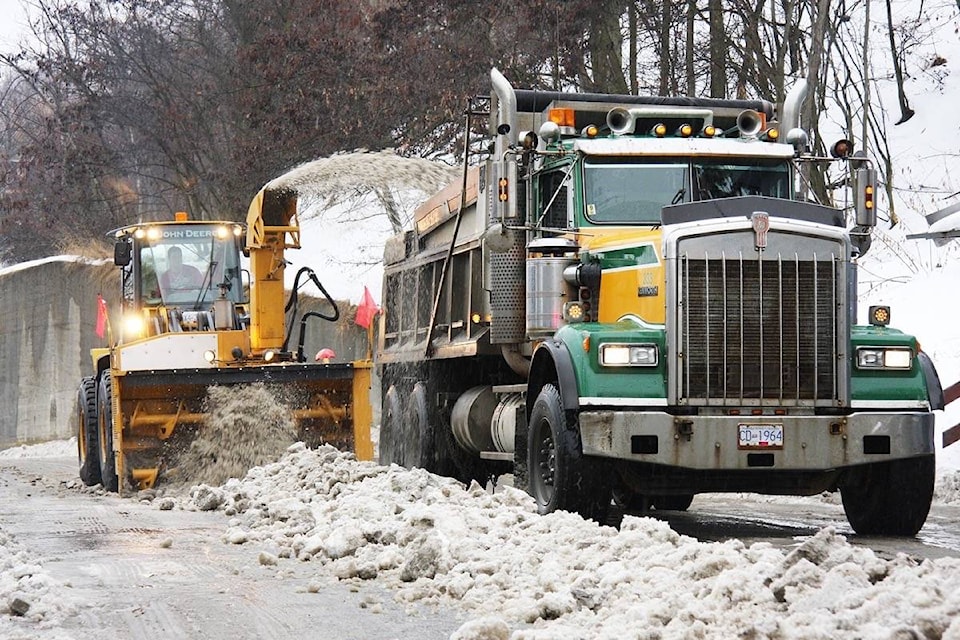An extraordinary amount of snow calls for an extraordinary amount of muscle to clear streets and sidewalks.
As double the usual snowfall piled up the first three months of 2018, so did municipal snow removal costs.
The City of Trail has already used most of its $558,500 budget, reports Mark Stephens, superintendent of grounds and roads.
By the end of March, Trail spent $480,400 on snow removal, which represents 85 per cent of the overall budget.
“On average, over the last five years, we have spent 70 per cent of the winter operations budget in the first quarter of the year,” Stephens explained. “However, we feel pretty good, given that in January, we received the most recorded snow accumulation in decades.”
Stephens pointed out the city doesn’t roll snow-related costs into one budget. It’s actually separated into six categories, or budgetary items, that encompass all aspects of snow removal.
“From sanding and plowing streets,” he explained. “To sidewalk snow removal both by city staff and contractors, to snow removal by city staff and/or contractors.”
Testing salt brine on two West Trail hills was a new expense added this season.
“The brine test was successful,” Stephens said. “And a detailed review of the cost associated with brining roads with in the city will be conducted.”
With an early winter last year, the first snowfall was Nov. 3, the city spent $544,400 on removal costs, which was 18 per cent above budget.
The story is similar in Rossland, Warfield, and Beaver Valley - barring anymore freak snowstorms this spring - there’s still November and December to go.
Darrin Albo, Manager of Operations for Rossland, says the city experienced about 35 per cent more snow than the average snowfall for the first few months of the year.
“We didn’t have any major problems other than more complaints,” he explained. “As people, and the city, were running out of places to put snow.”
So far, Rossland has used approximately 80 per cent of its $464,000 allotment.
Even if snowfall is normal this winter, Albo projects the municipality will exceed budget by about 31 per cent, or $221,000.
Last year, Rossland wound up eight per cent over budget by spending just over $490,000 on snow removal costs.
As far as the in-between point, the Village of Warfield, the usual snow removal budget is $80,000.
Corporate Officer Jackie Patridge says another $10,000 was tacked on to 2017’s snow removal costs, which include labour, fuel, supplies and equipment.
“We ended the year spending $85,000,” she noted. “The snow budget for 2018 is also $90,000.”
To date, the village has spent more than half of those funds.
“In order to stay on budget, snowfall for November and December of 2018 has to be a little lighter than November and December of 2017,” said Patridge.
The village has three full-time employees and two part-time contractors to plow snow.
“We paid a significant amount of overtime this year as it always seemed to snow on weekends,” she explained.
Besides timing, another hiccup was ongoing snow accumulation. The village has plows to push, but no machinery to blow snow into a truck.
“So we are unable to remove snow,” Patridge concluded. “One of our biggest problems was finding places to push the snow, as we received so much in a short period of time.”
As far as snow removal costs, Montrose fared slightly better the past two winters.
In 2017, snow removal costs went over budget by $1,900, confirmed Chief Administrative Officer Larry Plotnikoff.
The usual allotment is $36,500 but that was upped to almost $39,000 for 2018.
To date, approximately $24,000 has been spent on snow removal.
“Based on figures for this time of year we appear to be right on budget for the rest of the year for snow clearing,” he said.
Noticeably shorter turnaround times on the freeze/thaw/snow cycles in December and January were challenging at times, Plotnikoff added.
“Many Interior B.C. communities, including Montrose, faced particularly challenging snow conditions the past couple of seasons,” he concluded. “Our crews do a good job with the equipment we have to keep our roads safe and clear for our residents.”
Fruitvale numbers were not available by press time.
